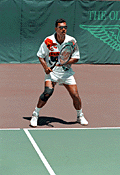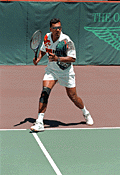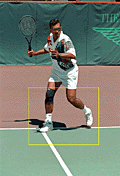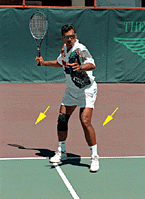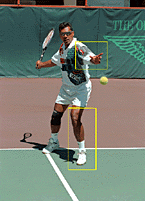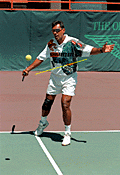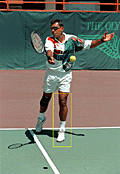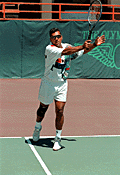|
TennisOne Lessons
The Return of Serve - Move to the Ball!Nigel O'Rouke - Head Professional, Olympic Club The return of serve is one of the two most important strokes in tennis - the other one being the serve. Consider the mighty Sampras and the mighty Agassi. One has the best serve in the game, the other the best return. Yes, they both have excellent shot making capabilities, but whether they win the championship (and beat each other) usually revolves around how well Sampras serves or how well Agassi returns. Now back to the return. The server has one primary goal when serving - to open up the court. The server begins the process of opening up the court by serving hard, forcing the receiver to stand back. Now, with the receiver standing further back, the server has greater options to increase the angle of his wide serves.
The first photo below shows me in the corner, protecting more against the wide serve than the serve down the middle. Just as the server begins his tossing motion, I move slightly forward, intent on cutting off the angles, moving forward aggressively, moving to the ball. In the second and third photo I have read the wide serve to the forehand and have stepped out and unweighted the left leg (see McLennan basic forehand lesson). Note that I have clearly stepped into the green area of the court, moving forward and into the ball.
The metaphor of the hammer and nail is a fitting metaphor for the serve and return. In reality, the hammer hammers the nail and the nail helplessly and passively waits to be hammered. If the receiver feels like a nail - helpless - the receiver will appear passive and rarely move to the ball. In fact, the common picture of the receiver on his heels, leaning away from the serve, can arise as much from the passive attitude as from poor preparation (see Basynat's early preparation lesson). Think of Agassi as he prepares to return and he looks anything but passive. Indeed, he attacks the serve, thereby reversing the metaphor: the nail hammers the hammer. As you read through our tennis library, you will find many references to the non-dominant arm. The previous photo sequence again indicates just how much the non-dominant arm is used in the forehand stroke. Just like Agassi or Sampras, in the same motion I have brought my left arm back with the racquet. As I unwind into the shot my left arm moves in synch with my left foot. Balanced and turning into the shot, I swing with a longer lever than if my left shoulder had not turned into the shot. As you scroll through the final three photos below, note how the left arm clears. Measure the distance from the sweet spot to the left elbow. This is the long lever, the big stick if you will, that I use to generate power. At the same time, I remain balanced and controlled, ready to attack the serve.
|

